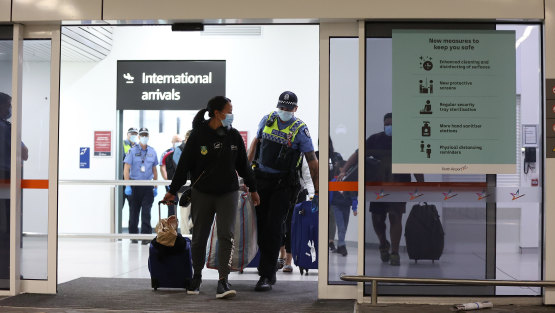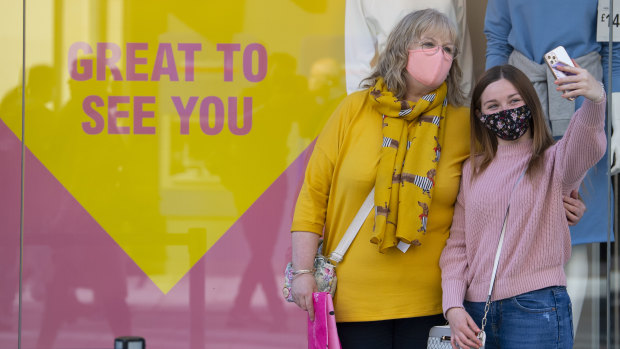This was published 3 years ago
Opinion
We must use caution to break out of Fortress Australia
By Brendan Crabb and Mike Toole
COVID Zero is precious. We are now experiencing a quality of life that approximates pre-pandemic days and most Australians want to keep it that way. But while the objective of zero COVID-19 community transmission will be with us for some time, it should not mean Fortress Australia.
Reopening our international borders will have enormous benefits. Not only will Australians be able to reunite with overseas family and friends but we will again welcome skilled migrants, international students and tourists – all essential for full economic recovery.

Border closures have stopped people coming in and going out. Credit: Getty Images
We need to be ambitious about opening a pathway that lets people move freely into and out of Australia. But for the foreseeable future – most likely years – we can’t think of our borders as steel doors that are either shut or open. A reopening of the border should be cautious and based on evolving circumstances, evidence and an agreed public health strategy.
Australia faces three substantial uncertainties when it comes to this endeavour: how much of our population has to be vaccinated to protect against severe disease and widespread circulation of the virus; how effective vaccines will be against emerging variants; and how long vaccine protection lasts.
It’s fair to say that Australia’s vaccine rollout has been slow. At the current pace of 426,000 doses a week, we can expect to reach the 40 million doses needed to fully vaccinate Australia’s adult population in mid-January 2023. The pace will pick up as we receive more vaccines later this year, although maybe not as rapidly as we’d like.
And how confident are we that high vaccination rates will protect us from viruses introduced by international travellers? Among the 10 countries with the highest vaccination rates, cases of COVID-19 are in decline in Israel, the United States and Britain. However, in four other countries – Seychelles, Bahrain, Chile and Maldives – cases surged to record levels after they had vaccinated more than half their population.

Two shoppers welcome the reopening of non-essential retail in Wales in April.Credit: Getty
So it seems we’ll need to vaccinate a very high proportion of Australians to fully protect our population. And even then, will it be enough? We don’t yet know enough about emerging variants of concern to be confident that these viruses circulating in a strongly vaccinated population will be manageable. The B.1.617 variant, first identified in India, is especially worrying. And it’s unlikely to be the last; more infectious variants of concern are likely to emerge while there is widespread global transmission.
The evidence shows countries that pursued elimination of COVID-19 have achieved vastly better health and economic outcomes than those that allowed community transmission. This means for some time we will need to maintain zero COVID through quarantine that we can trust will help people, and not the virus, move in and out of the country.
However, other than the Howard Springs facility, the quarantine system is not working as well as it could. Since the leak in Adelaide last November, there have been 18 breaches of hotel quarantine in five cities. From the information publicly known, it appears that most of these leaks were due to airborne transmission.
To protect Australians, we deserve the very best kind of quarantine system and that is fit-for-purpose facilities like Howard Springs in every state. Meanwhile, we need a standardised system of hotel quarantine rather than a patchwork of different approaches. That means all jurisdictions must address airborne transmission through attention to ventilation and the provision of N95 masks and eye protection to staff in at-risk areas of hotels.

Returned Australian travellers at the Howard Springs quarantine facility over Christmas.Credit: Louise Radcliffe-Smith
Transmission of coronavirus via small particles, called aerosols, is not a fringe theory. It is based on solid evidence, such as a study of airborne transmission to 12 congregants in a Sydney church last July. It is endorsed by the World Health Organisation and the US Centres for Disease Control. However, national guidelines are nowhere near as explicit as they could be on preventing airborne transmission.
In the immediate future our priorities must be an accelerated vaccination program and an improved, higher-capacity, airborne-ready quarantine system. Once highly vaccinated we will have learned more about the risks associated with variants and what the best options are. It is unlikely that the gates will be flung open at that stage but more nuanced and relaxed approaches to minimising virus entry could be trialled and adopted. A traffic light system assessing risk, home-quarantine, and home-based testing are all possibilities.
Our aim with borders is to not unduly risk the restriction-free cake we are now enjoying, while eventually eating the benefits of open borders. That’s a hard, nuanced and probably quite long path that we simply must take.
Mike Toole is a medical epidemiologist with the Burnet Institute, of which Brendan Crabb is chief executive. The institute is an independent not-for-profit organisation that links medical research with practical action.